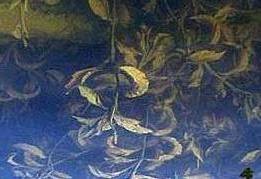Largeleaf pondweed
(Potamogeton amplifolius)

Description
Potamogeton amplifolius, commonly known as largeleaf pondweed or broad-leaved pondweed, is an aquatic plant of North America. It grows in water bodies such as lakes, ponds, and rivers, often in deep water. This perennial plant grows from rhizomes and produces a very slender, cylindrical, sometimes spotted stem up to a meter or so long. The leaves take two forms. Submersed leaves are up to 20 centimeters long by 7 wide and may be folded along their midribs. The submersed leaves have more veins than do those of other pondweed species, up to 49. Floating leaves are up to 10 centimeters long by 5 wide, leathery in texture, and borne on long petioles. The inflorescence is a spike of many flowers rising above the water surface on a thick peduncle. Potamogeton is a genus of aquatic, mostly freshwater, plants of the family Potamogetonaceae. Most are known by the common name pondweed, although many unrelated plants may be called pondweed, such as Canadian pondweed. The genus name means "river neighbor". Potamogeton species range from large to very small. Height is strongly influenced by environmental conditions, particularly water depth. All species are technically perennial, but some species disintegrate in autumn to a large number of asexually produced resting buds called turions, which serve both as a means of overwintering and dispersal. Turions may be borne on the rhizome, on the stem, or on stolons from the rhizome. Most species, however, persist by perennial creeping rhizomes. In some cases the turions are the only means to differentiate species. The leaves are alternate, which contrasts with the closely related genus Groenlandia, where the leaves are opposite or whorled. In many species, all the leaves are submerged, and in these cases, they are typically thin and translucent. Some species, especially in ponds and very slow-moving waters, have floating leaves which tend to be opaque with a leathery texture. Leaf shape has been found to be highly plastic, with variability due to changes in light, water chemistry, planting depth, sediment conditions, temperature, photo period, waves, and seasonality. All Potamogeton have a delicate membranous sheathing scale, the stipule, at the leaf axil. This may be wholly attached, partly attached, or free of the leaf, and it may have inrolled margins or appear as a tube. The morphology of the stipule is an important character for species identification. The stems have small scales.
Taxonomic tree:







